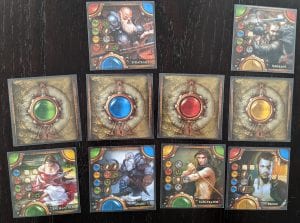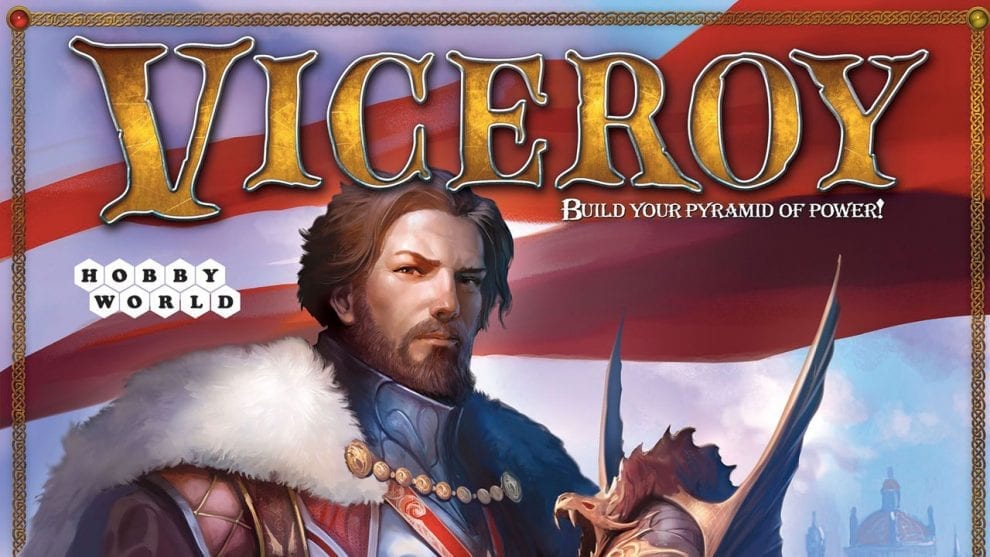Disclosure: Meeple Mountain received a free copy of this product in exchange for an honest, unbiased review. This review is not intended to be an endorsement.
I played the original Viceroy game a few years ago but never bought it. It was one of those circumstances where I like the game, but my friends’ impressions were lukewarm. Going back to this game again, the issue was never Viceroy; I just needed better friends.
Nevertheless, this is no nostalgia trip. After several years since its initial release, this game finally has an expansion called the Times of Darkness. Since I never reviewed Viceroy, I think this is an excellent opportunity to look at the original game and the expansion in a two-part review. Today we are going to focus purely on the base game.
So what is Viceroy? It’s a card game about grabbing people from a row of cards and sticking them to your pyramid of power. You are a political opportunist enlisting allies from various social classes to achieve dominance in the hybrid magic and steampunk world of Laar. It involves appointing people to certain levels of your homemade hierarchy like a Fortune 500 CEO without the cocaine.
It Starts with the Bones
Everyone will start with a handful of colorful gems behind their player shields and a single character card in their pyramid of power. These gems are your currency you use for auctions or assigning your characters into your pyramid. Besides character cards in your hand, you also have law cards you can put in your pyramid for free. They have effects that either give you immediate rewards or create end-of-game scoring opportunities exclusively for you.
Every turn undergoes the same process. You have an Auction Phase followed by a Development Phase. Auction phases will let you bid on cards to add them to your hand. In the Development Phase, you play cards from your hand to put them into your pyramid of power. That’s the skeleton of this game. Now let’s talk about the muscle.

Fantasy LinkedIn
In the middle of the gaming space will be four auction cards representing the four various colored gems. At the start of the game and the end of every auction phase, draw four new cards from the character deck and place them beneath each auction card. Any characters from an earlier auction move above the auction cards.
There are three rounds of bidding where everyone can either try to win one of the available character cards or pass to get some gemstones plus bonuses for each Science token they have. Auctions are performed simultaneously using closed fists. While this sounds like a standard auction affair we have seen before, there are significant changes to the formula.
The first obvious one that comes to mind is the open-ended negotiation before the closed fist. You can make promises and deals with your friends before committing to a bid. The other crucial element is you can only use one gemstone for the auction. After the players reveal their bids, any players with matching colored gemstones will Clash. Unless multiple cards of a single color are in play, they get nothing and must discard their gems, while those with their own colors get the character cards. Anyone who did not pass or get a character card plays the next auction round.
Bidding Wars
Due to the unrelenting player interaction, this auction system provoked a massive uproar among players and critics. Travel to the Boardgamegeek forums, and you will be ambushed by variant rule posts to ‘fix’ this perceived problem. I will wrap myself in arrogance and make this simple statement about the auction system: It is neither bad nor good. It is brilliant.
My problem with most negotiation games is they often end up going towards the same destination, even if the scenery looks completely different. You will downplay your board position while propping your target’s standing using sales tactics. Nothing more.
That mindset does not work here. Because of the mutual destruction of clashing colors, it forces you and your friends to have a discussion with some actual integrity for once. Sure, you can bully your friends with your abundance of red gemstones, but you’ve just passed your last turn, and you prefer to retain every gem for your next few cards. If you are on the opposite side of the power scale, tackling someone with more gemstones than you is simply a dumb move. That’s like uppercutting a grizzly bear and expecting not to be turned into a meat pinata.
That’s why I like this auction system. It fosters an honest conversation between friends, even if that honestly isn’t always going to be in your favor. It is cruel yet fair, with everyone showing off their knives on the table instead of concealing them.

Building Your Future
Now that we have gone over the auctions, we need to discuss the cards we just bought. The Development Phase is where the magic happens, and you have three rounds to play your cards from your hand. Each round, you and your friends will play a card face down or pass. If you pass, you cannot play any more cards. Flip the cards over, and everyone will slot their cards into their pyramid.
The pyramid itself is a clear-cut process. Like any stable structure, you need a foundation before putting things on top of it. In Viceroy’s case, you need at least two cards side-to-side to build upward. To build on the next level, you place your card above the two bottom cards, forming a triangle.
There is a catch. Each card has parts of a sphere on it. When you build your three-card triangle formation, the circle becomes whole. If all of the sections are one color, you instantly gain a gemstone of that color. While that is a great gift, the real reason you want to chase this color perfection is every single solid color circle earns you points at the end of the game. The higher the level, the more points you earn, yet you need to spend more gemstones to place your characters on higher levels.
Reaping the Rewards
That’s only half the battle; The other half is the rewards for placing a card. Your reward will vary depending on the level you placed on your character card. Some of them are straightforward, such as gaining three gemstones of your choice, drawing a card, and earning victory points. Then some require a few sentences to explain.
The magic scrolls? They are worth nothing and do nothing. You can harvest their potential by taking another token that gives you points per magic scroll you possess. If you prefer to stick to circles of a specific color, then there is a bonus token for that strategy as well. Additionally, Infinite Gems give points at the end of the game and provide a permanent discount during the Development phase.
My favorite is the Swords. Unlike the other tokens, you do not place the Swords in your pyramid. Instead, they go behind your cardboard shield with your gemstones since you can use them in an auction. Use one of these bad boys, and you can grab whatever you like before everyone else. Sounds good, but the rulebook suggests not to do this because they have another function. At the end of the game, each sword you have is worth -4 points to everyone else. The only way to negate Sword tokens is to have Shield tokens. Finally, a mechanism to stifle other players’ progress without resorting to boring tactics like removing cards or stealing them.
There is a fascinating quirk at the end of the game as well. After completing twelve turns, you use your excess gemstones to “paint” sections of the spheres in your pyramid to make them a single color. This end game rule suggests that you don’t need to be such a perfectionist while playing your cards, as long as you can position yourself at the very end to abuse your gemstones.

Wearing Many Hats
While I did make that lame CEO joke at the beginning of this review, there is a grain of truth buried in that line. This game demands you to take on various roles while exploring the social and mechanism layers it provides. You need to identify the best character for your pyramid scheme and compromise with your friends during the auction. The pyramid you are crafting is both your savior and enemy as you try to plan your way to get the right tokens. You must manage your gemstones like an accountant during tax season to avoid sabotaging your growth. Monitoring your friends and anticipating their needs is an essential skill to be competitive in Viceroy.
All of this sounds fantastic, so why did this game get lost in the Sarlacc Pit of time?
The auction system is the biggest perceived issue, despite all players having the chance to bid on a card three times. I’ve already gone into too much detail about that and don’t need to repeat that here. Another grievance is the limited player interaction, and I can somewhat understand that perspective.
There are only two ways to interact with the other players: Auctions and Sword tokens. Once a card is in your hand, no one can prevent you from playing that card. The same goes with any card that goes to your pyramid.
It’s All About the Performance
Usually, I would be annoyed by this because I want to play against my friends, not with them. Even so, I approve of Viceroy’s method since you must solve this appealing yet perplexing riddle while under the gaze of a palatable rule system.
Therefore, we must view the situation through a different lens. I cannot approach this game as if I were thrown into the ring with my friends to fight them. It is more of an open stage with everyone performing like they are in a gymnastics tournament, with every step judged by a glossy rule book. Competition is still here, but the focus is on each individual’s performance instead of taking everyone down.
Ultimately this would be the perfect multiplayer solitaire game for me. The limited player interactions work well in the context of the game’s systems. With so many ways to score points, this game has the legs to run past my expectations. Nevertheless, there are some issues in the game that I cannot overlook.

The Blade is Dull
Player scaling is one of these issues. No matter how many hands are playing, you still have four auction spots. Two hands and four cards mean there is very little reason to have any discussion with your opponent. You will likely get what you want, thus erasing the negotiation aspect of the game. I’ve seen mime performances that were more vocal than a two-player game of Viceroy.
Another problem is the starting card. You draw a hand of character cards, and you place one for free in your pyramid. Sounds easy until you realize that not every reward is equal. For example, you can have three gemstones of your choice while your opponent has four. That might sound as impactful as a peashooter, but this game’s economy relies heavily on gemstone scarcity. Even having one more than your opponent is a big deal.
The final problem is the Law Cards themselves. I’m going to break the reviewer code and talk about balance. Simply put, some law cards are either completely useless or stupidly overpowered. I don’t even have to go into great detail about this because the Times of Darkness expansion gives you revised Law cards to mend these issues.
Expanding the Pyramid
Come to think of it, all of the troubles I listed above are solved in the Times of Darkness expansion. Open the box, flip to page three of the rulebook, and you’ll see revised law cards, domain cards, and two-player auction cards.
It also raises the question of Viceroy without the expansion: Is it any good? It’s a decent game and a beast all its own. However, these problems I bought up will eventually rub you like a cactus, and the pain will eventually settle in. I have to say that I wished the reworked components were in the original box because they change the game quite a bit from a competitive perspective.
At this point, I haven’t played the expansion modules yet, and my fingers are tired from all this typing. Next time we will look at the three modules in the Times of Darkness expansion.












Add Comment